An Analysis of Jonathan Harvey’s “Mortuos Plango, Vivos Voco”
Mortuos Plango, Vivos Voco is a tape composition by British composer Jonathan Harvey. Completed in 1980 as a commission by the Centre George Pompidou in Paris, it was realized at IRCAM (Institute de Recherche et Coordination Acoustique-Musique) with the technical assistance of Stanley Haynes (Harvey 1981, 22). The piece is based on two natural sound sources; the great tenor bell at Winchester Cathedral and the voice of Harvey’s young son, a chorister there from 1975 to 1980 (Manning, 233). The title and text of the work are taken from the bell’s inscription: “Horas Avolantes Numero, MortuosPlango: Vivos ad Preces Voco” [I count the fleeting hours, I lament the dead: the living I call to prayer]. Harvey analyzed the bell’s harmonic spectrum with the fast Fourier transform (FFT) program at IRCAM. Synthesizing and mixing was done with IRCAM’s version of MusicV, originally created by Max Mathews in 1969. (1) The boy’s voice was synthesized from a live recording using the singing synthesis program CHANT developed by Gerald Bennett and Xavier Rodet. (2)

I conducted my own analytical research in relation to this work to further investigate the harmonic spectra of the bell and the boy’s voice. Samples were taken directly from the compact disc recording of Mortuos Plango, Vivos Voco (Harvey 1990) and saved as Sound Designer II stereo sound files at a sampling rate of 44100 Hz. All samples were analyzed with the 1992/93 spectral analysis program AnnaLies Version 3.2, created by Chris Scallan and Thomas Stainsby based on the 1991 program AnnaLies Version 1.0 by David Hirst and Thomas Stainsby. (3) The software performs a Short Time Fourier Transform (STFT) analysis of the samples and stores the information in a Fast Fourier transform (FFT) file, which can then be displayed in a 2D or 3D format. For comparative analysis, all samples recorded were analyzed at a window length and hop size of 4096 samples, with a hamming window type, a start sample at 0Hz and end sample at 44100Hz. The purpose of this investigation is to analyze the harmonic spectrum, find the formant regions present in each sample and compare the results, especially in the vocal vowel sounds.

Mortuos Plango, Vivos Voco contains eight sections. Each of the sections is announced by and based on one of the eight lowest partials from the bell’s harmonic spectrum (Harvey 1981, 22). Modulations from one bell transformation to another are generally achieved by sine-tone glissandi and/or tacet pauses. The partials present are related to the following pitches and corresponding frequencies rounded up to the nearest whole number; example 1 shows C3=138Hz, C4=261Hz,Eb4=311Hz, F4=349Hz, C5=523Hz, F5=698Hz, G5=784Hz and A5=880Hz. The analyzed sample taken at (00:48) of the opening bell toll verifies these eight harmonics and their intensities. Each harmonic present relates not only to the pitch material but also to the duration of each section (Harvey 1990, liner notes), (i.e. the higher the partial, the shorter the duration and vice versa). While the durations are inversely proportional to the partials of the tenor bell, further calculations show that they are also based on the Golden Section. This is proven when the ratio formed by the proportions of the longer segment (A) to the shorter section (B) is equivalent to that of the whole to the longer segment, where A:B::(A+B):A. (4) To calculate the Golden Section of this work, the total duration of the work (08:58) is converted to 538 seconds and multiplied by the average Golden Mean percentage of 0.618, producing the A value of 333 seconds. Then the A value is converted back into minutes and seconds, with a result of 5 minutes and 33 seconds. On comparing the A value to the existing sections of Mortuos Plango, Vivos Voco, it is discovered to be the exact starting time of Section G. To find the value for B, the same calculations apply, this time with a starting value of 5 minutes and 33 seconds. The end result for B is 3 minutes and 26 seconds, or 206 seconds. (Further calculations place the values for A and B into the equation [B/A=A/(A+B)] producing the equal resultant ratio of 0.618...= 0.618... thus proving that the overall form is based on the golden mean). The A value includes the Sections A through F and the value B, Sections G to the end of H, as delineated in the analysis (see Diagram 1).
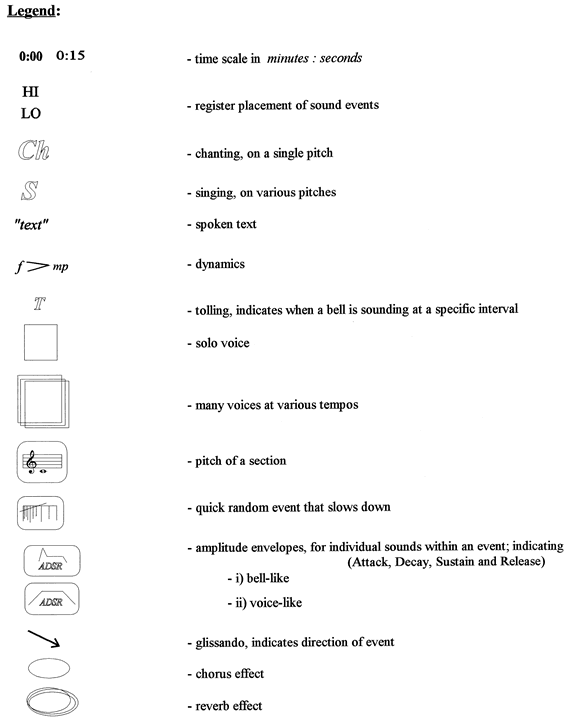
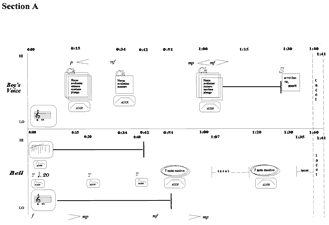
The first section (Section A, 00:00–01:41) is based on the second partial of the eight lowest partials of the bell, C4. It is the second longest section of the work with a duration of 1 minute and 41 seconds (see Section A and Diagram 2). Section A begins with a quick succession of tolling bells on various pitches. This quickly chiming figure gradually slows down, decreasing in volume and variety of pitches until it eventually stops at 00:42. As the chiming is fading out, a single distinct bell toll on C4 is heard in intervals of 20 seconds at 00:00, 00:20 and 00:40. The boy’s voice first enters quietly within multiple entries at 00:15 while chanting the text “Horas Avolantes Numero, Mortuos Plango” on the pitch C4. The chanting varies in tempo and increases in volume while the bells’ loudness decreases. At 00:34 the boy’s voice enters again on C4 (this time as a solo voice), chanting “Horas Avolantes Numero.” When the single bell tolls again at 00:51 it is imposed with the envelope of the voice, thus producing a longer attack with no immediate decay, prolonged sustain, and a gradual release. This seven note bell motive (beginning with the pitches C4, G4 and F4) fades out to silence by 01:07 while the voice merges chanting at 01:00 to 01:29. The chanting is first heard, with many voices chanting to the same text, “Horas Avolantes Numero, Mortuos Plango,” at varying tempos. As the chanting fades out, the seven note bell motive is repeated at 01:20 to 01:36. During the return of the motive, at 01:34 to 01:39 the voice begins to sing alone quietly the text “a-vo-lante, mort.” The last consonant of “mort”, is emphasized both by a strong accent from the voice and by the absence of any other sounds. The consonant “t” is of a percussive quality and contains mostly noise. When displayed in a 3D image it is clear that it has a short attack and very little sustain, similar to that of a bell-like envelope (5) (see Example 2). Therefore, when consonants occur in the voice, they are acting like the bell toll and when a bell sound has been imposed with a voice-like envelope, it is acting as a vowel sound. In Section A the consonant “t” is followed by one second of silence 01:40 to 01:41 representing the end of one section and the beginning of the next.
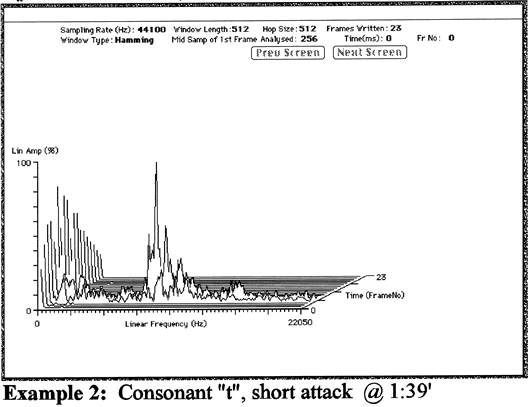

Section B (01:41–02:13) is based on the seventh partial of the bell, G5, and is the shortest section, with a duration of 32 seconds (see Section B). It begins with a short bell toll on G5. The voice then enters with an accented solo spoken consonant “t” at 01:46. The bell toll has been transforming since the beginning of the section from a bell-like envelope to a voice-like envelope. While this is occurring the vowel sounds “aa” (“father”) and “o” (“more”) at 01:49 are being sustained through chanting. The vowel sounds are quickly transformed by 01:51 into short consonants with a bell-like envelope; a short attack, immediate decay, little sustain, and a short release. Solo chanting emerges at 02:09 on the text’s phonemes, “ha raa”. Here the last syllable “aa” is sustained until an ascending and descending glissandi begins in the voice. Taking a sample of this vowel “aa” (“father”) the formant region can be seen occurring on the third harmonic at 2640Hz with the fundamental at 880Hz (see Example 3). Harvey Fletcher’s 1953 study states that the formant region for “aa” is around the frequency region of 900Hz. When the fundamental of this sample is taken down one octave and a fifth to D4 (294Hz), the formant region is almost one third of the original at 882Hz, corresponding to Fletcher’s findings. (Fletcher, 53) Once the glissandi begin, it is this figure that modulates the work into the next section. Modulation between the bell’s partials, and thus the sections, occur either by tacet breaks or transforming glissandi.

Section C (02:13–03:31) is unique in this work as it is the only section where only the bell sonorities are used. It is based on the fourth partial of the bell, F4, and is the third longest section with a duration of 1 minute and 18 seconds. This section opens with both a short bell toll on F4 and a bell sound with a voice-like envelope and a wide fluctuating vibrato. These sounds continue until the next bell toll at 02:36. This bell toll is accompanied by a short cluster of quicker bell tolls in varying registers. Ascending and descending glissandi in the lower register begins at 02:44, and is followed by an ascending and descending glissando in the middle register at 02:50. Two more bell tolls are heard in succession at 03:05. While the glissandi are transformed into an ascending glissando in the upper register which continues until the tacet at 03:28 to 03:31. It is then both the glissandi and silence which usher in Section D.

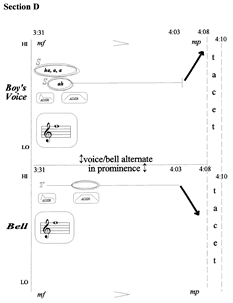
Section D (03:31–04:10) is based on the sixth partial of the bell, F5, an octave higher than the previous section. It is the third shortest section with a duration of 39 seconds. Like all the sections in Mortuos Plango, Vivos Voco, it is announced with a bell toll on a pitch from the tenor bell’s harmonic spectrum. In this case, the voice announces the opening simultaneously with the bell toll on the pitch F5 singing the text “ha, a, a”. Both the bell and the voice begin with bell-like envelopes that quickly become voice-like envelopes by the end of their initial releases. It is in this sustaining texture that the bell-like and voice-like qualities alternate in prominence for most of the section. This changing of sound quality over time, is evident in the 3D image of a sample taken of this event (6) (see Example 4). Here the voice’s intensity is shown increasing over time while the bell’s intensity is decreasing over time. Such a technique was accomplished by reading both the bell and boy’s voice sound files forward and backwards in rapid oscillations of various rhythms (Harvey 1981, 24). It is these constant transformations between the sounds of the boy’s voice and of the bell that unify these contrasting sources of material (Manning, 233). By 04:03 the voice and the bell sonorities have begun to decrease in dynamics and begin to glissando, ascending and descending respectively. Both continue in opposite directions until the tacet occurs (04:08–04:10), setting up anticipation of the next section and signaling the close of Section D.

Section E (04:10–04:59) is the fourth shortest section in Mortuos Plango, Vivos Voco, lasting 49 seconds. The pitch it is based on is C5, the fifth partial in the bell’s spectral analysis. The section opens with three simultaneous events: the first being a sung vowel sound “aa” on C5. The remaining events include a bell toll on C5 and a group of short bell sonorities at various upper-register pitches. By 04:15 the bell sounds have ended and downward, continuously-spiraling glissandi on the vowel, “aa,” begins. These glissandi continues until 04:46. The bell sonorities at this point remain tacet for the remainder of the section. A chorus of voices enter at 04:30 singing the text, “preces” with varying rhythms. At 04:46 ascending glissandi on “aa” takes over all of the voices. It is this chorus of glissandi that modulates to the next bell partial, A5, marking the end of Section E by 04:59.


Section F (04:59–05:33) is based on the eighth partial of the bell, A5, and is the second shortest section in duration, lasting only 34 seconds. Similar to Section E, it begins with two simultaneous events. The first is a sustained bell toll on A5 and the second consists of chanting on A5 the vowel “ee”. Taking a further look into the vowel “ee” (“eat”) the formant region occurs on the fifth harmonic at 4430Hz with the fundamental at 880Hz (see Example 5). When the fundamental is taken down one octave to A4 (440Hz) the formant region is half of the original at 2215Hz corresponds with Harvey Fletcher’s 1929 study that states the formant region for “ee” is around the frequency regions of 300 and 2300Hz (Fletcher, 53). The bell toll with it’s voice-like envelope is sustained until the tacet at 05:19 to 05:24. The vowel “ee” chanting continues until its transformation into the vowel “aa” (“father”) at 05:19. This vowel “aa” is then repeated while its sound envelope changes from that of a voice-like sustain to a bell-like attack. As the attack is being shortened, the text also undergoes a transformation from chanted vowels to rapidly spoken consonants at 05:24. This process of transformation then extends to changing the vocally produced consonants to rapidly tolling bell sounds at various pitches at 05:27. It is these bell sonorities that continue while decreasing in tempo and dynamics until the end of the section at 05:33.
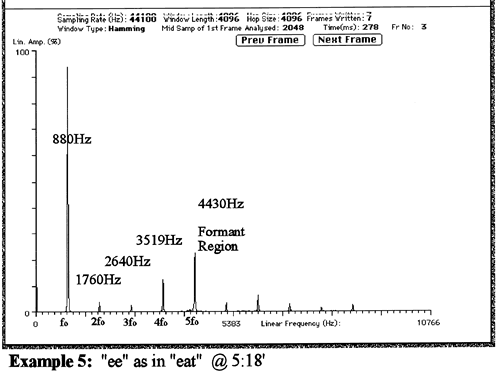
Unlike previous modulations, Section G (05:33–06:33), is neither preceded by pitch transforming glissandi nor by a tacet pause. This section begins with a pulsing bell toll on E-flat 4, the third partial of the tenor bell. The bell toll’s dynamics continue to pulsate for the remainder of the fourth longest section, exactly one minute in duration. The boy’s voice enters at 05:44 singing on a vowel sound, “aa” (“father”) that pulsates and sustains to the end of the section. At 05:44 bell sounds at various pitches are heard mixing in and out of the pulsating bell tone that already exists. Mixed voices of varying tempos enter at 06:15 singing the vowel “aa”, mixing with the previously sustaining “aa” still on E-flat 4. A chorus singing the same vowel appears at a sforzando dynamic at 06:30 with a burst marking the end of the section at 06:33. Section G does not end with a tacet pause or glissandi, like the ending of the previous section.


The last part of this work, Section H (06:33–08:58) is actually on the first partial, C3, of the bell’s spectrum. It is also the work’s longest section, lasting 2 minutes and 25 seconds. Like Section A, it is announced with a bell toll that continues to toll on the pitch of the section every twenty seconds. In this case, the bell toll is an octave lower than the opening on the pitch C3. The other noticeable difference from the opening constant bell toll is the increased reverberation. This is applied to the sound gradually and eventually takes over the bell’s qualities and becomes the bell itself after 08:26 until it fades out to end the work at 08:58. While this transformation and constant tolling occur with the bell sonorities, a chorus effect of the boys’ voice sings a quick chord at various intervals (06:34, 06:49, 07:06, 07:18, 07:32, 07:41, 07:55, 08:15 and 08:26). From analyzing the harmonics present in the vocal chorus, it represents a B-flat minor chord. (see Example 6) This is evident as the following pitches are present in each chord; D-flat 3, B-flat 3, D-flat 5, F5, B-flat 5 and D-flat 6. The chord itself has a unique quality as it uses the vowel sound “oo” (“moon”) and “aa” (“father”) simultaneously adding a hollow, breathy like quality to the sound. It is this variance of dynamics and timings that make these chords so effective against the strict tempo of the bell tolls.
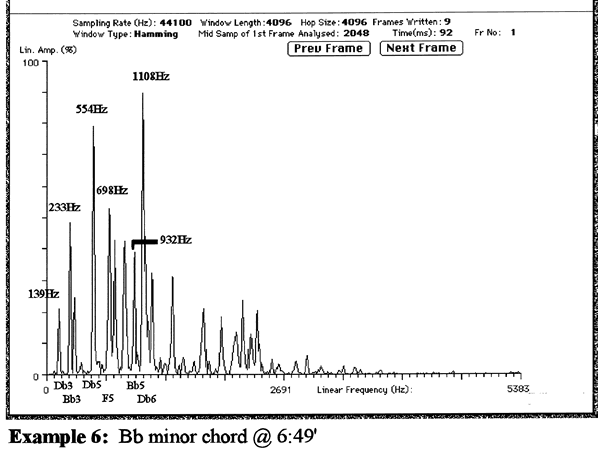
In conclusion, Mortuos Plango, Vivos Voco has best been described as an important addition to the repertoire of compositions that employ digital signal processing (Manning, 233). From its sonorities to the harmonic content of the work, the durational proportions of each section and treatment of amplitude envelopes, it is clearly based on the tenor bell. The bell’s partials are statically distributed in space producing the sonic impression of being inside the bell, whereas the boy’s voice has the tendency to act as a free moving spirit throughout the concert hall (Harvey 1990, liner notes p.14). One could take the contrast of the bell and the boy’s voice one step further in regards to the inscribed text, “Horas Avolantes Numero, Mortuos Plango: Vivos ad Preces Voco,” and interpret the bell as representing the dead and the boy’s voice, the living.
Notes
- For more information about the program MusicV, see Stanley Haynes, “The Musician-machine Interface in Digital Sound Synthesis,” Computer Music Journal 4/4 (1980), 23–44, and Max Mathews, The Technology of Computer Music (Cambridge: MIT Press, 1969).
- For a more technical discussion of Harvey’s analysis and synthesis techniques, see Jonathan Harvey, 1981.
- For more information about the program AnnaLies, see David J.G. Hirst, “Digital Sound Analysis and Synthesis Using the Short-Time Fourier Transform” (M.A. Thesis, La Trobe University), 1985.
- Values used in the above calculations were rounded up to the nearest whole number for the purpose of not dealing with units less than one second in duration.
- This sample was re-analyzed at a window and hop length of 512 samples for the purpose of producing a larger display area only.
- This sample was re-analyzed at a window and hop length of 1024 samples for the purpose of producing a larger display area only.
References
Backus, John. The Acoustical Foundations of Music. 2nd ed. New York: W.W. Norton and Company, 1977.
Fletcher, Harvey. Speech and Hearing in Communication. New York: D. Van Nostrand Company Inc., 1953.
Harvey, Jonathan. Mortuos Plango, Vivos Voco. Computer Music Currents 5. Wergo, WER 2025-2, 1990.
_____. “Mortuos Plango, Vivos Voco: A Realization at IRCAM.” Computer Music Journal 5/4 (1981), pp. 22-4.
Manning, Peter. Electronic and Computer Music. 2nd ed. Oxford: Clarendon Press, 1993.
Other Articles by the Author
Reviews
Robert Normandeau, Claire de terre. Computer Music Journal Vol. 29, No. 2 (Summer 2005), pp. 94–6.
Various, Electroshock Presents Electroacoustic Music, Volume VII. Computer Music Journal Vol. 28, No. 4 (Winter 2004), pp. 96–8.
Various, Harangue II. Computer Music Journal Vol. 28, No. 4 (Winter 2004), pp. 98–100.
Various, Presence II (Canadian Electroacoustic Community). Computer Music Journal Vol. 25, No. 2 (Summer 2001), pp. 84–5.
Hans Tutschku, Moment. Computer Music Journal Vol. 25, No. 4 (Winter 2001), pp. 100–102.
Social top